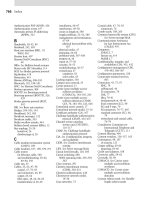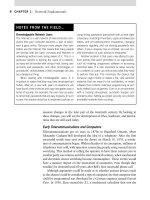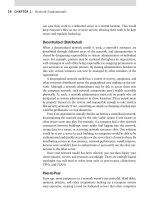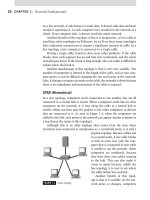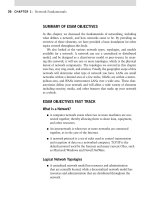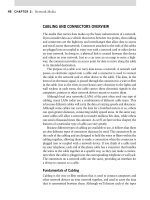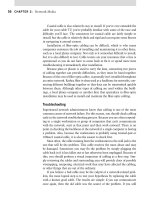CompTIA Network+ Certification Study Guide part 19 potx
Bạn đang xem bản rút gọn của tài liệu. Xem và tải ngay bản đầy đủ của tài liệu tại đây (80.33 KB, 10 trang )
CHAPTER 4: Switching 166
C. Install a bridge to break the larger LAN into two smaller ones,
and then connect these to the other LAN using a switch.
D. Install a switch to break the larger LAN into two smaller ones,
and then connect these to the other LAN using a switch.
A small network consists of three computers named Alpha, Beta, 6.
and Omega. Alpha sends a message to Omega, and the data is
passed through a switch. When it reaches the hub, which of the
following will occur?
A. The message is broadcast to all of the computers on the
network.
B. The message is sent out on all of the ports. Beta will ignore the
message because it isn’t intended for that computer.
C. The message will only be sent out on the port connecting to
Beta.
D. The message will only be sent out on the port connecting to
Omega.
You are the network administrator of a large company that has 7.
experienced several hacking attempts in the past. You decide to
install a new IDS on your network. Which of the following will be
required so that the IDS can view data going across a switch?
A. Port authentication
B. Port mirroring
C. VLAN
D. Trunking
Your company is looking at replacing all of the standard 8.
telephones used in its offices with IP telephones. The initial
analysis shows that there would be a cost savings to the
company using IP telephones, but there is a concern that there
would be a high initial cost of having to install new electrical
outlets to power these devices. Which of the following could
be used to power the IP telephones without needing to install
additional power outlets?
A. PoE
B. STP
C. Trunking
D. VLAN
Self Test 167
You have decided to implement redundant switches on your net-9.
work that will enable packets of data to take the best possible route
to their destination. Which of the following features will you want
on the switches that will be used on this network so that looping
doesn’t occur?
A. STP
B. UDP
C. TCP
D. IDS
You have installed new cabling to accommodate a new section of 10.
the building that is being networked. Once computers are installed,
you find that they are unable to connect to the network. You
believe the problem is that the length of the cabling has exceeded
the maximum distance allowed. You want to fix the problem with
the least amount of cost and work. Which of the following will
you do?
A. Remove the cabling and install cable that supports a longer
distance.
B. Install a passive hub to increase the distance that data can travel
along the cable.
C. Install a NIC to increase the distance that data can travel along
the cable.
D. Install a switch to increase the distance that data can travel
along the cable.
A computer wants to send data to another computer on the 11.
network. Before it can send the data, it must send its credentials
to a server that verifies that it has access. Which of the following
is being used?
A. Port authentication
B. Port mirroring
C. VLAN
D. Trunking
You want to have computers in different buildings to be part of the 12.
same broadcast domain, so that when a computer sends a broad-
cast message, all of the computers in that domain will receive it.
What will you do to achieve this?
CHAPTER 4: Switching 168
A. Use a switch to establish a bridge between the two networks.
B. Use port mirroring to have the broadcast sent to computers in
the other building.
C. Implement a VLAN so that all computers can be part of the
same VLAN and receive broadcasts.
D. Use trunking to connect the two networks together.
A client is attempting to send data across a port that requires 13.
authentication. In attempting to send data across the network in
this situation, what role does the client play?
A. Supplicant
B. Authenticator
C. Authentication server
D. File server
You have set up several VLANs on your network. You want to have 14.
computers that are part of the same VLAN that are in different
buildings connected by a single network link. Which of the follow-
ing will you use to implement this?
A. Multiport bridging
B. STP
C. Create a new VLAN that will incorporate the different
computers you want connected together as part of the same
VLAN.
D. Use trunking to connect the two virtual networks together.
A client is attempting to send data across a port that requires 15.
authentication. In attempting to send data across the network in
this situation, what role does the port play?
A. Supplicant
B. Authenticator
C. Authentication server
D. File server
Self Test Quick Answer Key 169
SELF TEST QUICK ANSWER KEY
A1.
B2.
D3.
B4.
B5.
D6.
B7.
A8.
A9.
D10.
A11.
C12.
A13.
D14.
B15.
This page intentionally left blank
171
CHAPTER 5
EXAM OBJECTIVES IN THIS CHAPTER
RADIO FREQUENCY AND ANTENNA BEHAVIORS AND
CHARACTERISTICS 175
WIRELESS NETWORK CONCEPTS 179
COMMON EXPLOITS OF WIRELESS NETWORKS 200
CONFIGURING WINDOWS CLIENT COMPUTERS
FOR WIRELESS NETWORK SECURITY 216
SITE SURVEYS 220
INTRODUCTION
Wireless networking has provided a new era of data connectivity unmatched
by cabled networks. Increases in the speed of deployment, access to data, and
scalability mean that the needs of specific user communities can be addressed
in ways that were unavailable to network architects a few years ago.
New streams of end user applications and services are being developed to
provide businesses and consumers with advanced data access and manipula-
tion. The main benefits of wireless integration will fall primarily into two
major categories:
Convenience
Productivity
Convenience
First and foremost in the minds of Information Technology (IT) professionals,
business leaders, and end consumers when discussing wireless networking is
the aspect of convenience. This basic benefit more or less outweighs all other
benefits combined in terms of user interest in wireless and is predominantly
Wireless Networking
CHAPTER 5: Wireless Networking 172
the main reason for their deployments. Convenience can be broken down
into three areas of interest:
Flexibility
Roaming
Mobility
Flexibility
Wireless technologies provide the greatest flexibility of design, integration,
and deployment of any networking solution available. With only transceiv-
ers (wireless network adapters) to install in the local station and a wireless
hub or access point (AP) to be configured for local access, it is simple to retro-
fit wireless networking within existing structures, or to create access services
where traditional networking infrastructures cannot go.
With traditional networking infrastructures that mostly rely on copper or
fiber-optic cabling, a physical path is required between the access concentra-
tor (a hub or switch) and each of the end users of the network. This means
that a cabling run has to be created from one end of the network to the other
for users to communicate with each other, whether they are using worksta-
tions or servers.
Wired access drops are generally static in location in that the access is
provided from a specified point that cannot easily be moved from one physi-
cal location to another. This also implies that if an existing access drop is in
use, other users must wait their turn to gain access to the network if the next
closest available drop is not conveniently located. The only other way to nav-
igate this issue would be to install yet another concentrator (hub or switch)
so that more users can share that preexisting cable drop. Existing environ-
ments may not always be “new installation friendly”. Many older buildings,
houses, and apartments do not provide facilities for installing new cabling.
In these environments, building contractors and engineers may need to get
involved to devise ways of running new cabling systems. When existing cable
run facilities are available, they do not always offer the most optimum path
between existing local area network (LAN) resources and new users. Security
concerns also have to be addressed if a common wiring closet or riser is to
be shared with other tenants. As such, the cost involved in installing new
cabling can be prohibitive in terms of time, materials, or installation costs.
Another factor involved in the installation of new cabling is loss of rev-
enue due to the unavailability of facilities during the installation itself. Hotel
chains, convention centers, and airports stand to lose revenues during a cable
installation retrofit project if a section of the building has to be closed off to
customer access for safety reasons during the installation.
Introduction 173
Intangible costs have to be explored as well when investigating the instal-
lation of new cable runs. These include customer dissatisfaction and loss of
customer goodwill during and after the retrofit project.
With wireless networking all that is required to create a new network is
unrestricted radio wave access between end nodes and/or between an end
node and a wireless AP within the vicinity of the end nodes. Radio waves
can travel through walls, floors, and windows, which gives wireless network
designers the flexibility to design wireless networks and install APs where
needed. This means that a wireless AP, when properly placed, can be used to
support multiple user environments at the same time.
An example of this in a wireless LAN configuration would consist of
locating a wireless AP on the inner side of an eastern-facing exterior wall on
the second floor of an office building. This one wireless AP could simultane-
ously serve the needs of a group of users on the eastern corner of the first
floor, second floor, and third floor, along with those on the terrace located
outside the first floor eastern corner. In this configuration, access is provided
to users located on different floors inside and outside the building with a
minimal commitment in terms of equipment and resources.
Another example of a wireless LAN configuration would consist of pro-
viding networking access within a large public area such as a library. In this
scenario, properly placed APs could provide network coverage for the entire
floor area without impacting the day-to-day use of the facilities. In addition,
the APs could be located in an area of the library that has restricted access
and is physically secure from daily activities.
Roaming
A wireless network access zone is an area of wireless network coverage.
Compared to traditional wire-based networks, a wireless user is not required
to be located at a specific spot to gain access to the network, although the
user must be in range of the AP. A user can gain access to the wireless net-
work, provided he or she is within the area of wireless coverage where the
radio signal transmissions to and from the AP are of enough strength to
support communications. For a more flexible and robust solution, you can
organize multiple APs to overlap coverage in a single area, thus allowing
users to roam seamlessly between APs without a loss of connection. With
the always-on connectivity provided by wireless LANs, a roaming user is one
that has the ability to:
Physically roam from one location to another within the wireless
access zone.
Logically roam a session from one wireless AP to another.
CHAPTER 5: Wireless Networking 174
When discussing physical roaming, we would include both the movement
of a user within a single AP’s wireless network access zone or within the
combined network access zones for all the APs that are part of this network.
When discussing logical roaming we refer to the transference of a network-
ing session from one wireless AP to another without the need for any user
interaction during the session reassociation process. When a user moves from
one wireless AP’s area of coverage to another AP’s area of coverage, the user’s
transmission signal strength is assessed. As the signal reaches a threshold, the
user credentials are carried over from the old “home base” AP to the new “home
base” AP using a session token or other transparent authentication scheme.
This combination of physical and logical roaming allows users to keep
data sessions active as they move freely around the area of coverage. This
is of great benefit to users who require maintaining a data session with net-
worked resources as they move about a building or facility.
An example of this would be an internal technical service agent. In their
day-to-day activities, these agents may be called upon to service end stations
where access to technical troubleshooting databases, call tickets, and other sup-
port resources may be required. By having access to these services over the wire-
less network, the technicians can move from one call ticket to another without
being forced to reconnect to the wire line network as they move about. Another
benefit to maintain an always-on session is that they could provide live updates
to the ticketing databases or order replacement supplies at the time of service.
Next, we take a look at a senior manager who is attending a status
meeting in a conference room where a limited number of data ports will be
available to access e-mail, databases, and other information stores. If this
manager had access to wireless networking capabilities on their laptop, he
or she could maintain a connection to the same services that are available
at the local desktop. Real-time reports with up-to-the-minute metrics on
business activities and critical information flows could be accessed more
efficiently. The road to the top might actually be a little simpler.
As we mentioned earlier, the lack of wired lines provides the network archi-
tect with the ability to design networking solutions that are available anytime
and anywhere through always-on connectivity. As noted in the previous exam-
ples, any networking solution using traditional wired line media would hit a
hard limitation when exposed to the same requirements of access coverage.
The costs in cabling materials alone would preclude any such contemplation.
Mobility
The last concept dealing with convenience is that of mobility. This benefit
alone is often the biggest factor in an organization’s decision to go for a
wireless-based networking solution.
Radio Frequency and Antenna Behaviors and Characteristics 175
In traditional wired networking environments, once a cabling infrastruc-
ture is set in place, rarely does it move with tenants when they leave to a new
facility or area of a building. Cabling installations are considered part of the
cost of the move and are essentially tossed out.
With a wireless networking environment, the wireless APs can be
unplugged from the electrical outlet and redeployed in the new facility. Very
few cables, if any, are left behind as a going away present to the building
owner. This allows the network architects to reuse networking equipment as
required to address the networking realities of each environment.
For example, it is possible to move part or all of a network from one func-
tional area to another or from one building to another. This facilitates the
job of IT managers who are constantly faced with network resource rational-
izations and optimizations such as the decommissioning of access ports, or
the moving of equipment and personnel from one area to another.
Test Day Tip
Mobility, roaming, and all the benefits of wireless network over that of wired networks
covered in this chapter are all background information for you so that when items such
as Wired Equivalent Privacy (WEP), frequency hopping spread spectrum (FHSS), and
Fresnel Zone are covered, you understand them well enough to sit the Network exam.
It’s very important to have a good background on wireless technologies. Even though this
is not a wireless test, wireless technologies are spreading in use so quickly … it would be
a career-limiting move not to understand the fundamentals.
Productivity
The net result of the increased level of flexibility, mobility, and convenience
provided through wireless networking is increased productivity. Networked
resources can become accessible from any location, thus providing the ability
to design and integrate environments where users and services can be located
where best suited. Wireless networking can provide opportunities for higher
levels of service and productivity unmatched through cabled networking.
RADIO FREQUENCY AND ANTENNA BEHAVIORS AND
CHARACTERISTICS
Before actually getting into the specifications and standards that define
how wireless networks are constructed and operate, one must first have a
good understanding of basic radio frequency (RF) behaviors and antenna
characteristics. In the following sections, we will briefly examine these
topics.
